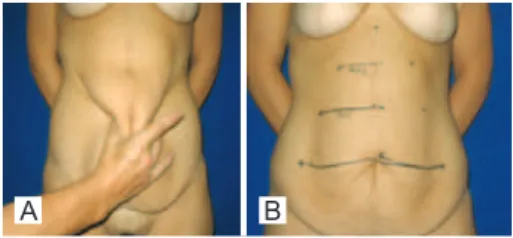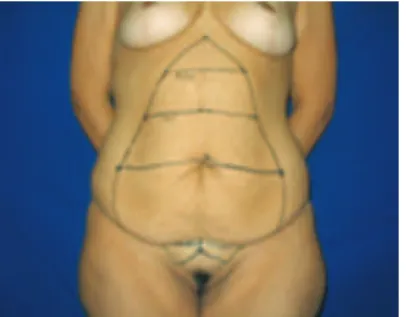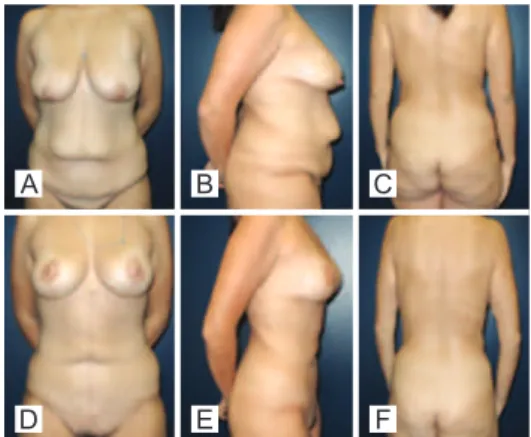Abdominoplasty after gastroplasty: evaluation
of 100 cases operated on by the “ish” technique
Dermolipectomia abdominal pós-gastroplastia: avaliação de 100 casos
operados pela técnica do “peixinho”
ABSTRACT
Background: Morbid obesity is a worldwide endemic disease. Its growing incidence makes it a public health problem. Bariatric surgery is an alternative weight loss method with the
objective of controlling obesity-associated diseases and improving quality of life. The sur
gical treatment of the deformities resulting from signiicant weight loss is a new challenge for plastic surgeons. This paper presents a new technique for abdominoplasty in formerly
obese patients with a midline abdominal scar resulting from gastroplasty. Methods: A total
of 28 men and 72 women who underwent abdominoplasty after gastroplasty by the “ish” technique described in this study were analyzed. Results: The results obtained with the te
chnique presented were satisfactory, resulting in a new body contour and a low complication
rate. Conclusions: Abdominoplasty with markings forming a ish shape is successful for the removal of excess abdominal skin in patients who underwent bariatric surgery.
Keywords: Surgery, plastic/methods. Abdomen/surgery. Gastroplasty. Bariatric surgery.
RESUMO
Introdução: A obesidade classe III é uma doença endêmica em todo o mundo. Trata-se de problema de saúde pública em decorrência de sua incidência progressiva. A cirurgia bariátrica
oferece alternativa de redução ponderal, visando ao melhor controle das doenças que têm a obesidade como fator de risco e à melhoria da qualidade de vida. O tratamento cirúrgico das deformidades secundárias a grandes emagrecimentos é um novo desaio ao cirurgião plástico. O objetivo deste trabalho é apresentar uma nova técnica para abdominoplastia do paciente ex-obeso, portador de cicatriz abdominal mediana decorrente de gastroplastia. Méto-do: Foram analisados 28 homens e 72 mulheres, submetidos a dermolipectomia abdominal pós-gastroplastia, segundo a técnica do “peixinho”, apresentada neste trabalho. Resultados: A técnica apresentada demonstrou-se satisfatória, resultando em novo contorno corporal,
com baixo índice de complicações. Conclusões: A abdominoplastia com marcação em peixe é mais uma opção no arsenal do cirurgião plástico para tratamento do excedente cutâneo do abdome de pacientes submetidos a cirurgia bariátrica.
Descritores: Cirurgia plástica/métodos. Abdome/cirurgia. Gastroplastia. Cirurgia bariátrica. Study conducted
at Clínica Vitória, Belo Horizonte, MG, Brazil. Submitted to SGP (Sistema de Gestão de Publicações/Manager Publications System) of RBCP (Revista Brasileira de Cirurgia Plástica/Brazilian Journal of Plastic Surgery). Paper received July 01, 2011 Paper accepted: October 31, 2011
1. Full member of the Brazilian Society of Plastic Surgery (SBCP), specialist member of the Brazilian Association of Cranio-Maxillofacial Surgery (ABCCMF), medical coordinator of the Center for Treatment and Rehabilitation of Cleft Lip and Palate and Craniofacial Deformities (CENTRARE), plastic surgeon, head and coordinator of the Plastic Surgery Service of Hospital da Baleia, Belo Horizonte, MG, Brazil.
2. Full member of SBCP, plastic surgeon at Hospital Mater Dei, Belo Horizonte, MG, Brazil.
3. Specialist member of SBCP, plastic surgeon at Hospital das Clínicas of Universidade Federal de Minas Gerais, Belo Horizonte, MG, Brazil. 4. Specialist member of SBCP, specialist member of ABCCMF, plastic surgeon at Hospital Santa Genoveva, Uberlândia, MG, Brazil. 5. Specialist member of SBCP, plastic surgeon at Hospital da Baleia, Belo Horizonte, MG, Brazil.
INTRODUCTION
Morbid obesity is a worldwide endemic disease. It is re
lated to genetic, endocrine, behavioral, and environmental
factors. Morbidly obese patients are at an increased risk of de
veloping diabetes, cardiovascular diseases, and the condition can also be fatal. There are about 15 million obese people in the United States and among them approxima tely 5 million are morbidly obese. In Brazil, it is estimated that there are about 10 million obese people, of which 100 thousand are
mor bidly obese. Bariatric surgery was developed with the purpose of reducing the risk factors associated with obesity
and to improve the quality of life of these individuals. Specialized centers and multispecialty teams have de -veloped specific treatment protocols, including surgical, nu tritional, and psychological management of obese pa
-tients. Candidates for surgery should have a body mass
in dex (BMI) > 40 or BMI > 35 along with comorbidities.
As the bariatric surgery technique evolved, malabsorptive procedures were replaced by mixed techniques (restrictive and malabsorptive), which offer a better nutritional prognosis
for the patient1.
The plastic surgeon is responsible for removing the cu -taneous excess skin arising from signiicant weight loss2.
Vertical and horizontal skin sagging and a supraumbilical me dian scar are common consequences of gastroplasty. Ini -tially, the plastic surgeon is responsible for advising the
for merly obese patient with regard to the patient’s expecta tions3 of the outcome of plastic surgery. The reconstructive
character of the surgery, the possible generation of new scars,
and the limitations of the classic abdominoplasty should be
emphasized4,5.
Abdominoplasty for the treatment of excess skin in formerly obese patients began with Kelly6, at the beginning of the 20th century. In the 1960s, several variations of the procedure were proposed by authors such as Castañares
& Goethel7, who described a vertical and horizontal resec tion resulting in an anchor-like final scar. In the 1970s,
Regnault8,9 advocated the removal of the cutaneous excess with an incision in a “leur-de-lis” pattern. Pitanguy10 deve
loped the method of transverse abdominoplasty, with large detachment of the abdominal lap and plication of the rectus abdominis muscle for diastasis correction. These techniques are still in use by many surgeons. Procedures that combine the use of dermolipectomy, in which large detachments are made, are recommended for improvement of the excess skin. These procedures require two highly skilled surgeons with their associated staff, and result in large, round, and
vertical scars11-13.
In 2003, we introduced a new option for abdominoplasty
in postbariatric surgery with the purpose of improving body
contour and minimizing scarring and blood loss14,15. This paper describes the results of this novel abdominoplasty
technique in formerly obese patients with a median abdo minal scar resulting from gastroplasty.
METHODS
Abdominoplasties were performed in 100 formerly obese patients with median xyphoumbilical scars resulting from gas troplasties. All patients were operated on by the same
ge neral surgery team using the technique of Fobi-Capella.
A total of 28 men and 72 women who participated in the
study were operated between June 2003 and June 2008. The
average age of the patients at the time of the plastic surgery
procedure was 34 years. The average weight loss was 51 kg. The weight of the patients had stabilized over 5 months with a BMI < 34. Abdominoplasty was performed after an
average of 17 months after the bariatric surgery procedure.
Surgical Technique
Surgical markings were performed with the patient in an upright position. A transverse line with the umbilical scar at
the center was drawn, and the horizontal cutaneous excess
was estimated at this level by means of bidigital clamping
(Figure 1A). This measurement ranged, on average, from 20 to 30 cm. The distance between the umbilical scar and the origin of the vertical scar from the previous laparotomy, which was close to the xiphoid appendix, was noted. This seg ment was divided into three equal parts, each measuring
about 5 cm. A transverse line was drawn between the lower
and intermediate segments with the median line at the center,
mea suring 70% of the length of the line drawn at the level of
the umbilical scar (Figure 1B).
A new transverse line was drawn between the interme
diate and upper segments with the median line at the center, measuring 70% of the length of the previously drawn line (for example, 1st = 20 cm, 2nd = 14 cm, 3rd = 9.8 cm).
In the natural crease of the abdomen, about 6 cm above the pubis, a line of similar length was traced to the most cranial line marked out (Figure 2A). The horizontal lines were joined
at the ends and up to the median point at the origin of the
vertical scar close to the xiphoid appendix, to determine the region to be removed. Two triangles between the pubic bone
Figure 1 – A, marking of the cutaneous excess by bi-digital clamping. B, marking of the area to
be resected by means of horizontal lines.
and the iliac fossa determined the region of additional skin
removal for the correction of “dog-ears” and sagging in the pu bic region (Figure 2B).
The final markings resemble the shape of a fish, giving this technique its name. The markings were confirmed with the patient in the supine position (Figure 3).
The patients were operated on under epidural anesthesia, and received cefazolin (2 g) as antibiotic prophylaxis and low molecular weight heparin (20 mg) as thromboembolic prophylaxis, from the eve of the surgery up to the 5th postope
rative day. The subcutaneous cellular tissue was iniltrated
along the markings with a 1:200000 adrenaline solution and
saline. The umbilical scar was isolated from the abdominal lap and maintained attached to the aponeurosis. Broken blood vessels were cauterized concomitantly to the removal of the dermal-adipose excess to minimize blood loss. The re moved excess skin was weighed. Plication of the rectus abdominis
muscles was performed by approximating the sides to the median line in two planes of continuous 10 nylon sutures.
The umbilical scar was attached to the abdominal aponeuro sis with separate 3-0 nylon sutures. After revision of sis, reconstruction was performed with Vicryl® 20 sutures
at the Scarpa’s fascia. The pubic region was attached at the
most caudal line previously drawn. Sagging of the skin in the pubic region and the need for correction of skin excess in the
lower abdomen were assessed, and excess skin was removed when necessary using the previously delineated compensation
trian gles. Skin removal at the pubic region was prioritized
to ensure that the resulting scar would be formed around it
wi thout extending laterally at the thighs or iliac fossa, leaving
a inal appearance of an inverted “Y”. In cases of pronounced pubic lipodystrophy, liposuction was performed with a 3 mm gauge “Mercedes” type cannula. The periumbilical skin was sutured to the aponeurosis with four to six 3-0 nylon sutures to avoid umbilical traction and consequent scar enlargement. The isolated umbilical scar was sutured to the abdominal skin using 4-0 nylon sutures. Reconstruction was performed in three planes with separate 3-0 Vicryl® sutures and colorless 40 Vicryl subdermal and 40 nylon intradermal sutures in
a sequence. Sterile gauze dressings and hypoallergenic tape
were used at the end of the procedure. A surgical compression
mesh was used for 30 days.
RESULTS
The weight of the excess dermal adipose tissue remo -ved ranged between 200 g and 6,000 g, with an average of 2,017 g. All patients were discharged one day after surgery, with weekly follow-up for 30 days and revision 6 and 12 months after surgery (Table 1).
The complications involved scar enlargement, especially at the umbilical scar, in 9% of the patients (observed in the irst cases that did not undergo ixation of the periumbilical skin to the aponeurosis), seroma in 6%, and hematoma in
1% of the cases.
All patients considered the scar to be of acceptable size
and were satisied with the overall result, and 8% of the pa -tients expressed a desire to undergo a “retouch” to improve
scar appearance.
All patients were able to carry out their daily activities 20 days after the operation.
The inal result was a new body contour, a xyphopubic ver -tical scar, and an inverted “Y” scar at the suprapubic region.
Figures 4 to 9 show the results obtained with some patients included in the study.
DISCUSSION
The signiicant weight loss of patients undergoing bariatric
surgery results in great distortion of body contour. Res trictions
A B
Figure 2 –A, marking of the lower line at the natural crease of the abdomen. B, marking of dog ears and rising of the pubis.
Figure 3 – Final marking: summarized scheme of the procedure.
Table 1 – Proile of the operated patients. Characteristics
Gender 72 women/28 men
Average age 34 years old (21 to 63 years old)
Preoperative BMI 26 kg/m² (22 kg/m² to 33 kg/m²)
Weight loss 51 kg (26 kg to 100 kg)
Removed lap 2,017 g (200 g to 6,000 g)
A
C
B
D
Figure 4 – A and B, preoperative images. C and D, postoperative period of 2 years; weight loss of 53 kg;
lap of 22 cm x 29 cm; lap weight, 1,100 g.
A
C
B
D
Figure 5 – A and B, preoperative images. C and D, postoperative period of 3 years; weight loss of 40 kg;
lap of 33 cm x 23 cm; lap weight, 1,450 g.
A
C
E
B
D
F
Figure 6 – A and B, preoperative images. C and D, postoperative period of 1 year. E and F, postoperative period of 5 years;
weight loss of 58 kg; lap of 30 cm x 45 cm; lap weight, 4,500 g.
A
C
B
D
Figure 7 – A and B, preoperative images. C and D, postoperative period of 2 years; weight loss of 51 kg;
lap of 33 cm x 24 cm; lap weight, 1,750 g.
A
C
E
B
D
F
Figure 8 – A and B, preoperative images. C and D, postoperative
period of 17 months. E and F, postoperative period of 6 years;
weight loss of 55 kg; lap weight, 700 g.
Figure 9 – A, B and C, preoperative images. D, E and F, postoperative period of 8 months; weight loss of 50 kg;
lap of 20 cm x 28 cm; lap weight, 1,200 g.
A
D
B
E
C
Correspondence to: Renato Rocha Lage
Rua Domingos Vieira, 319 – sala 701 – Santa Efigênia – Belo Horizonte, MG, Brazil – CEP 30150-240 E-mail: renatorochalage@hotmail.com
in movement and personal hygiene may result in cutaneous infections. A surgical approach is necessary to restore func tion and for aesthetic purposes.
The surgical approach proposed in this study is indicated in cases of vertical scars and signiicant sagging as a conse
quence of bariatric surgery. This approach has the advantage
of generating smaller scars and is accompanied by reduced blood loss due to the smaller detachment compared with the
techniques commonly used.
This technique showed satisfactory results, even in pa -tients with an abdominal apron. The compensation and rise of the pubis, which results in a scar over the pubic region (instead of horizontal compensation), is questionable, but is
very well accepted by patients.
The rate of complications among patients in the present study was comparable to those of other techniques reported
in the medical literature16,17.
CONCLUSIONS
Abdominoplasty with markings in the shape of a ish is an
option for the removal of excess abdominal skin in patients who underwent bariatric surgery.
REFERENCES
1. Capella JF, Capella FF. The weight reduction operation of choice: verti
cabanded gastroplasty or gastric bypass? Am J Surg. 1996;171(1):74-9. 2. Rohrich RJ. Body contouring after massive weight loss supplement.
Plast Reconstr Surg. 2006;117 Suppl. 1:1S-86S.
3. Kaluf R, Júnior DF, Nascimento CL. Peril psicológico dos pacientes sub metidos à terapia cirúrgica para obesidade. In: Heck JN, Ribeiro BG, eds. Estudos vida e saúde: Universidade Católica de Goiás. Goiânia: Editora da Universidade Católica de Goiás; 2005.
4. Kaluf R, Azevêdo FN, Rodrigues LO. Sistemática cirúrgica em pacien
tes ex-obesos. Rev Soc Bras Cir Plást. 2006;21(3):166-74.
5. Furtado IR, Nogueira CH, Lima Júnior EM. Cirurgia plástica após gas troplastia redutora: planejamento das cirurgias e técnicas. Rev Soc Bras Cir Plást. 2004;19(2):35-40.
6. Kelly HA. Excision of the fat of the abdominal wall lipectomy. Surg Gynecol Obstet. 1910;10:229-31.
7. Castañares S, Goethel JA. Abdominal lipectomy: a modiication in te -chnique. Plast Reconstr Surg. 1967;40(4):378-83.
8. Regnault P. Abdominoplasty by the W technique. Plast Recontr Surg. 1975;55(3):265-74.
9. Regnault P. Abdominal dermolipectomies. Plast Reconstr Surg. 1975; 2(3):411-29.
10. Pitanguy I. Abdominal lipectomy. Clin Plast Surg. 1975;2(3):401-10. 11. Pitanguy I. Contour surgery in the patient with great weight loss.
Aesthe-tic Plast Surg. 2000;24(6):406-11.
12. Roxo CDP, Pinheiro O, Almeida D. Abdominoplastia multifuncional. Rev Soc Bras Cir Plást. 2004;19(3):53-74.
13. Modolin M, Cintra W Jr, Gobbi CI, Ferreira MC. Circumferential ab
dominoplasty for sequential treatment after morbid obesity. Obes Surg. 2003;13(1):95-100.
14. Lage RR. In: Uma nova opção de abdominoplastia pós-cirurgia bariá-trica. In: XII Jornada Mineira de Cirurgia Plástica, III Simpósio de Ab dominoplastia; 2003 Out 16-18; Araxá, MG, Brasil.
15. Lage RR. In: Abdominoplastia pós-cirurgia bariátrica: uma nova opção. In: XXV Jornada Paulista de Cirurgia Plástica; 2005 Jun 9-11; São Paulo, SP, Brasil.
16. Schechener SA, Jacobs JS, O’Loughlin KC. Plastic and reconstructive
body contouring in the posvertical banded gastroplasty patient: a re
tros pective review. Obes Surg. 1991;1(4):413-7.
17. Costa LF, Manta AM, França AS, Cavalcante HA, Nahon M. Abdomi


